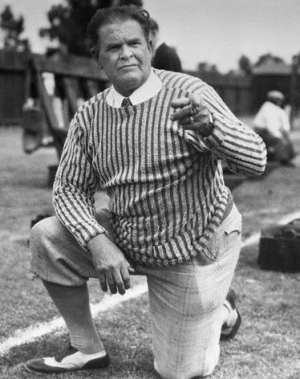Earlier this week, I began a post about 400-yard passing games with the words, “Whoever coined the phrase ‘statistics are for losers’ . . . .” Naturally, this got me wondering: Who did coin the phrase, anyway? Could I possibly trace it back to its origin?
Search engines were invented for tasks like this. Alas, I didn’t turn up anything conclusive — just as I didn’t, a while back, when I researched “A tie is like kissing your sister.” If only there were a registrar for these pithy statements, somebody who could go to a file drawer, pull out a card and say, “Ah, yes. Amos Alonzo Stagg first said that after the University of Chicago’s game against Wabash in 1905.”
Anyway, I did come across a few things worth passing along. For starters, there’s Steve Spurrier’s updated version, uttered in 1998 when he was coaching at Florida:
“Statistics are for losers and assistant coaches. Head coaches worry about wins and losses.”
(I’m not sure how assistant coaches like being lumped in with losers, but that’s The Ball Coach for you. He always shoots from the lip, collateral damage be damned.)
Three decades further back, in 1966, we have Jets coach Weeb Ewbank telling Arthur Daley of The New York Times after a loss to the Bills, “Statistics are for losers. Of course, it was encouraging that we could come back with 14 quick points in less than a minute during the last quarter. But getting in front early is much better than having to come from behind.”
That’s kind of the essence of Loser Statistics, isn’t it? The futile comeback that pads a team’s or player’s numbers and makes it look like they had a better day than they actually did.
Just a month earlier, the other pro coach in town, the Giants’ Allie Sherman, was quoted as saying, “Statistics are for losers. It’s the score that counts.”
So it’s clear that, by the mid-’60s, football folk were spouting the aphorism fairly regularly.
Four years before that, in 1962, The Associated Press reported: “The Cardinals outgained the 49ers, 314-215, [in a 24-17 defeat] but ‘statistics are for losers,’ [coach Wally] Lemm said.”
And two years before that, in 1960, columnist Ed Hayes of the Blytheville Courier-News in Arkansas wrote: “General Bob Neyland [the longtime University of Tennessee coach] . . . once cracked, ‘Statistics are for losers.’”
Unfortunately, when this “once” might have been is a mystery, though we do know Neyland was head coach of the Vols from 1926 to ’52. Still, there’s a good chance he might have heard it from somebody else. Coaches, after all, are notorious for stealing anything that isn’t nailed down — plays, drills, even handy sayings.
In the early days, when everything was up for grabs, the legendary Pop Warner tried to argue that statistics aren’t for losers. With college football plagued by low-scoring games in 1932,
Warner, then at Stanford, proposed that an additional point be awarded for each first down. His reasoning:
“The public likes a free-scoring game. Baseball men recognized this when they began to use a livelier ball. The change I suggest for football would make the games less common and would make the best team more likely to win. It would provide many more thrills — look at the cheers that go up now when the stakes are moved forward.
“The whole idea of the game would be to advance the ball, and by scoring a point for each first down it would make it advisable to take more chances on third and fourth downs, instead of always punting. I have advocated this change before, and some have said, ‘Oh yes, Warner wants to score first downs because he gains all his ground in the middle of the field,’ but I have no selfish motive in advocating this change. I firmly believe it would help the game, and we all know the game needs help right now.
“It would be advisable to except first downs resulting from a penalty of more than five yards and not count a first down made inside the opponent’s five-yard line, if a touchdown was scored on the next series of downs. This would prevent purposely downing the ball, say, six inches from the goal line on a long run.”
Pop sure had done some Deep Thinking about it, hadn’t he? But his proposal never gained much traction with the rules committee — probably because the vast majority of coaches were convinced, even if they hadn’t articulated it yet, that statistics really are for losers.


